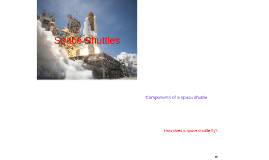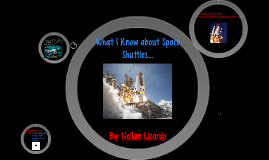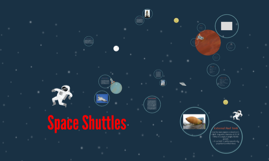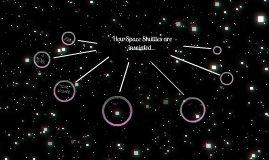Space Shuttles
Transcript: -usually 121 feet long -wingspan is 78 feet -tail height is 57 feet -made of mainly aluminum the size of a DC-9 Commercial Trailer -carry a payload of 65,000 pounds -payload bay is 60 feet long and 15 feet in diameter -the weight varies from 200,000 pounds-230,000 pounds when landed -designed for 100 space missions -forward fuselage where the cockpit is, crew cabin and work area is. -mid fuselage has the playload bay, the wing and -main landing gear attach points -aft fuselage holds the main engines, orbital maneuvering system (OMS) and the reaction control system pods (RCS), the wing aft spar, and the attach point for a vertical tail Main Engines External Tank Successful landing How does a space shuttle fly? -largest solid propellant motors -first to be used on a manned spacecraft -each made of 11 individual weldfree steel segments -joined by high-strength steel pins -each assembled motor is 116 feetlong, 12 feet in diameter -contains more then 1 million pounds of solid propellant -propellant burns at 5,5800 degrees Farenheit -generates liftoff thrust of 2.65million pounds -exhaust nozzels gimbaledto provide yaw,pitch and roll -solid propellant made of atomized aluminum powder (fuel), ammonium perchlorate (oxidizer), iron oxide power (catalyst), binder and curing agent -burn to achieve orbital altitude -after two minutes of flight, altitude of about 24 miles -casings separate from external tank -descend by parachute into Atlantic Ocean, recovered by ship, returned to land, and refurbished for reuse Getting to Earths Orbit Components of a space shuttle Lift Off -count down automatically controlled by Ground Launch Sequencer -16 seconds sound suppression system drenches Mobile Launcher Platform and SRB trenches with 300,000 gallons of water to protect orbiter -10 seconds,hydrogen igniters activated under each engine bell to quell stagnant gas inside cones before ignition; if not burned these gases could trip onboard sensors and create a possibility of an overpressure and explosion of vehicle during the firing phase -main engine turbopumps also began charging combustion chambers with liquid hydrogen and liquid oxygen the computers reciprocated action by allowing the redundant computer systems to begin the firing phase -main engines ignited sequentially Space Shuttles -liftoff -SRB separation/splashdown -main engine cutoff -ET separation -orbit insertion -on-orbit operations -deorbit -re-entry -landing -154 feet long -28.6 feet diameter -constructed primarily aluminum alloys -empty weight of tank 78,100 pounds -each has gross weight of 1,667,677 pounds -contains nearly 1.6 million pounds (143,060 gallons) of liquid oxygen -more then 226,000 pounds (526,126) liquid oxygen -only major part of space shuttle not reused after flight -has to fit weather criteria; precipitation, temperatures, cloud cover lightning, wind and humidity -not launched if conditions where could be struck by lightning -orbiter must be maneuvered into the proper position Crew Must -Close the cargo bay doors have been flying nose-first and upside down they then fire RCS thrusters to turn orbiter tail first -Once orbiter is tail first crew fires the OMS engines to slow orbiter down and fall back to Earth; will take about 25 minutes before the shuttle reaches upper atmosphere -During 25 minutes crew fires RCS thrusters to pitch orbiter over so that bottom of orbiter faces the atmosphere (about 40 degrees) moving nose first again -burn leftover fuel from the forward RCS as safety precaution because area encounters the highest heat of re-entry. Solid Rocket Boosters -main engines are operated by liquid hydrogen and liquid oxygen -each engine produces a sea level thrust of 375,000 pounds, and a vacuum thrust of 470,000 pounds -can pass over the thrust range by 65-109% -allows the high power during lift off and initial ascent -gives a power reduction during a final ascent to keep acceleration of orbit to three earth gravities -engines movable to control pitch,yaw and roll -operating time on normal engine for each flight about 8.5 minutes -each designed for 7.5 minutes operating Orbiter Preparation for lift off

















